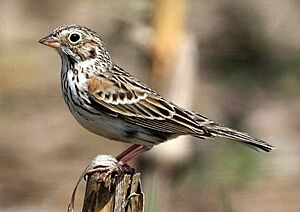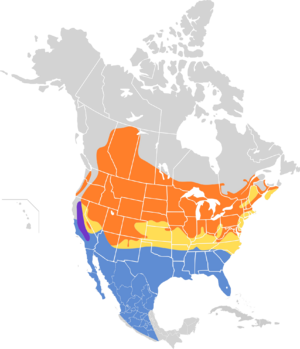Vesper sparrow facts for kids
Quick facts for kids Vesper sparrow |
|
|---|---|
 |
|
| Conservation status | |
| Scientific classification | |
| Genus: |
Pooecetes
|
| Species: |
gramineus
|
 |
|
| Range Breeding Migration Year-round Nonbreeding | |
The vesper sparrow (Pooecetes gramineus) is a medium-sized bird. It is a type of New World sparrow. This bird is the only one in its group, called Pooecetes. It has light brown feathers with darker streaks. Vesper sparrows live and raise their young in the grasslands of northern North America. When winter comes, they fly south to the southern United States and Mexico.
Contents
What is a Vesper Sparrow?
The vesper sparrow was first officially described in 1789. A German scientist named Johann Friedrich Gmelin gave it the scientific name Fringilla graminea. Later, in 1858, an American scientist named Spencer Fullerton Baird created a new group just for this bird, calling it Pooecetes.
The name Pooecetes comes from old Greek words. Poa means "grass," and oikētēs means "dweller." So, Pooecetes means "grass dweller." The second part of its scientific name, gramineus, is Latin for "grassy" or "grass-like."
Types of Vesper Sparrows
Scientists recognize three main types, or subspecies, of the vesper sparrow:
- P. g. gramineus: This type breeds in southeastern Canada and the eastern USA.
- P. g. confinis: This type breeds in southwestern Canada and the central-western USA.
- P. g. affinis: This type breeds in the northwestern USA.
How to Identify a Vesper Sparrow
Vesper sparrows are about 14 to 16 centimeters (5.5 to 6.3 inches) long. They weigh between 19.5 and 28.3 grams (0.7 to 1 ounce). Their upper feathers are light brown, and their belly feathers are light, both with dark streaks.
There are three special features that help you spot a vesper sparrow:
- They have a small, white ring around their eyes.
- When they fly, you can see flashes of white feathers on their tail.
- They have a reddish-brown patch on their shoulder. This patch is often hard to see.
Some vesper sparrows, especially those living west of the Cascade Range, might look a bit pinkish. Unlike some other sparrows, they do not have a strong line above their eyes.
Vesper Sparrow Song
Male vesper sparrows sing from high spots. They might sit on a shrub or a fencepost. Their song tells other birds that this area is their home. The song starts with two pairs of repeated whistle notes. It then ends with a series of fast, trilling sounds. It sounds a bit like the song of a song sparrow. They also use short, downward trills in their song.
Where Vesper Sparrows Live
Vesper sparrows are mostly found across Canada and much of the northern United States. They prefer grassy areas at lower elevations. You can find them in dry grasslands, areas with sagebrush, and open fields.
Around September, when autumn begins, these sparrows fly south. They migrate to the eastern and central United States, Mexico, and the Gulf Coast. They return north in March when spring arrives.
Vesper Sparrow Behavior
Vesper sparrows spend a lot of time on the ground. They often take dust baths and hop around. These birds search for food on the ground. They mostly eat insects and seeds. When it's not the nesting season, they often feed in small groups.
Reproduction and Life Cycle
During courtship, the male sparrow runs with his wings up. He might also jump around while singing his song. The female builds a loose, cup-shaped nest on the ground. She usually lays 3 to 5 eggs, most often 4.
The female sits on the eggs for 12 to 13 days. Both parents feed the baby birds, called chicks. The chicks leave the nest after at least 9 days. Vesper sparrows can raise two groups of babies each year.
Challenges for Vesper Sparrows
Even though the vesper sparrow is not an endangered species, its population has been shrinking. Between 1970 and 2014, their numbers went down by 30%. Today, there are about 34 million vesper sparrows.
Their relationship with farms is tricky. When farmland is changed into buildings or other developed areas, it means less space for the sparrows to nest. This is called habitat loss. However, farming can also harm them. Farm machines used for harvesting can destroy nests and eggs. Also, strips of land around farms that are left empty can reduce places for sparrows to hide. This makes them more open to predators.
Images for kids




